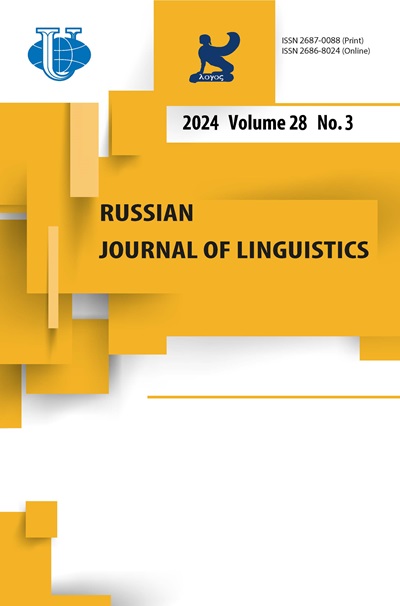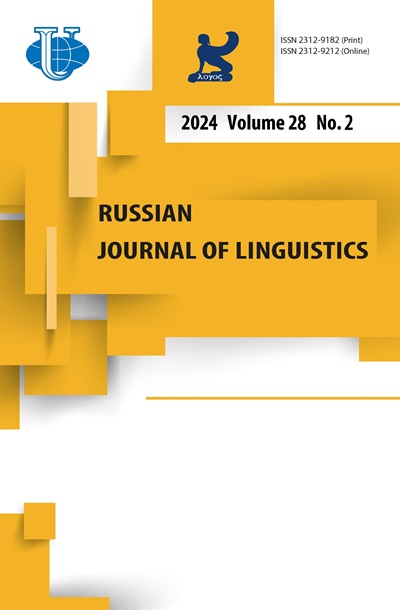Самофокусировка и диалогичность жестикуляции в синхронном переводе
- Авторы: Ченки А.1
-
Учреждения:
- Свободный университет Амстердама
- Выпуск: Том 28, № 2 (2024)
- Страницы: 227-242
- Раздел: Статьи
- URL: https://journals.rudn.ru/linguistics/article/view/39431
- DOI: https://doi.org/10.22363/2687-0088-34572
- EDN: https://elibrary.ru/CNYOFQ
Цитировать
Полный текст
Аннотация
Данное исследование посвящено рассмотрению вопроса о продуцировании жестов: жестикулирует ли говорящий в первую очередь для себя или для адресата? В статье рассматривается уникальная монологическая ситуация, характерная для синхронных переводчиков, которые работают в кабине, где они слышат, но не видят аудиторию и оратора, чью речь переводят. Гипотезы заключаются в том, что переводчики будут использовать больше репрезентирующих жестов, которые помогут им сформулировать идеи (гипотеза 1), и самоадаптеры, чтобы сохранить концентрацию внимания (гипотеза 2), а не прагматические жесты, которые выполняют интерактивные функции. Сорок девять переводчиков были записаны на видео в процессе перевода двух научно-популярных лекций: одной с английского или немецкого (не родного для них языка) на русский (их родной язык) и одной с русского на соответствующий иностранный язык. Результаты показали, что подавляющее большинство произведенных жестов либо выполняли прагматическую функцию, либо являлись самоадаптерами. Таким образом, вторая гипотеза подтвердилась, а первая - нет. Частое использование прагматических жестов интерпретируется с точки зрения интернализованной диалогической природы речи и самой жестикуляции. Как ритмичные жесты, использующиеся для акцентуации вербальной информации, так и редуцированные формы репрезентирующих жестов могут облегчить устную речь переводчиков, стимулируя процесс изложения и акцентирования идей. Несмотря на то, что переводчики-синхронисты сосредоточены на собственном процессе речепроизводства, они могут воспроизводить аспекты взаимодействия автора исходного текста с аудиторией, совмещенные с их собственным диалогическим поведением, аспекты которого проявляются в их жестикуляции.
Ключевые слова
Об авторах
Алан Ченки
Свободный университет Амстердама
Автор, ответственный за переписку.
Email: a.cienki@vu.nl
ORCID iD: 0000-0003-2951-9722
имеет степень PhD по славистике и является профессором лингвистики Амстердамского Свободного университета, Нидерланды. В сферу его научных интересов входят когнитивная лингвистика, семантика, исследование жестов, метафорология и анализ политического дискурса.
Амстердам, НидерландыСписок литературы
- Andries, Fien, Katharina Meissl, Clarissa de Vries, Kurt Feyaerts, Bert Oben, Paul Sambre, Myriam Vermeerbergen & Geert Brône. 2023. Multimodal stance-taking in interaction-A systematic literature review. Frontiers in Communication 8. 1187977. https://doi.org/10.3389/fcomm.2023.1187977
- Bakhtin, Mikhail, Michael Holquist & Caryl Emerson. 1981. The Dialogic Imagination: Four Essays by M. M. Bakhtin. Austin, TX: University of Texas Press.
- Bavelas, Janet B., Nicole Chovil, Douglas A. Lawrie & Allan Wade. 1992. Interactive gestures. Discourse Processes 15. 469-489. https://doi.org/10.1080/01638539209544823
- Boutet, Dominique, Aliyah Morgenstern & Alan Cienki. 2016. Grammatical aspect and gesture in French: A kinesiological approach. Russian Journal of Linguistics 20 (3). 132-151.
- Bressem, Jana & Cornelia Müller. 2014. The family of Away gestures: Negation, refusal, and negative assessment. In Cornelia Müller, Alan Cienki, Ellen Fricke, Silva Ladewig, David McNeill & Jana Bressem (eds.), Body - language - communication: An international handbook on multimodality in human interaction, 1592-1604. Berlin: De Gruyter Mouton.
- Brookes, Heather & Olivier Le Guen. 2019. Gesture studies and anthropological perspectives. Gesture 18 (2-3). 119-141. https://doi.org/10.1075/gest.00040.bro
- Cienki, Alan. 2021. From the finger lift to the palm-up open hand when presenting a point: A methodological exploration of forms and functions. Languages and Modalities 1. 17-30. https://doi.org/10.3897/lamo.1.68914
- Cienki, Alan & Gianluca Giansante. 2014. Conversational framing in televised political discourse: A comparison from the 2008 elections in the United States and Italy. Journal of Language and Politics 13 (2). 255-288. https://doi.org/10.1075/jlp.13.2.04cie
- Cienki, Alan & Olga. K Iriskhanova. 2020. Patterns of multimodal behavior under cognitive load: An analysis of simultaneous interpretation from L2 to L1. Voprosy Kognitivnoy Lingvistiki 1. 5-11. https://doi.org/10.20916/1812-3228-2020-1-5-11
- Clark, Herbert H. 2003. Pointing and placing. In Sotaro Kita (ed.), Pointing: Where language, culture, and cognition meet, 243-268. Mahwah, NJ: Lawrence Erlbaum Associates.
- Condon, William S. & W. D. Ogston. 1966. Soundfilm analysis of normal and pathological behavior patterns. Journal of Nervous and Mental Disease 143 (4). 338-347.
- Debras, Camille. 2013. L’Expression Multimodale du Positionnement Interactionnel (Multimodal Stance-taking). Paris: Université Sorbonne Nouvelle - Paris 3.
- Ekman, Paul & Wallace V. Friesen. 1969. The repertoire of nonverbal behavior: Cateogries, origins, usage, and coding. Semiotica 1 (1). 49-98.
- Freedman, Norbert. 1972. The analysis of movement behavior during the clinical interview. In Aron Wolfe Siegman & Benjamin Pope (eds.), Studies in dyadic communication, 153-175. New York, NY: Pergamon Press.
- Galhano-Rodrigues, Isabel & Elena Zagar Galvão. 2010. The importance of listening with one’s eyes: A case study of multimodality in simultaneous interpreting. In Jorge Díaz-Cintas, Anna Matamala & Josélia Neves (eds.), New insights into audiovisual translation and media accessibility, 241-253. Amsterdam: Rodopi.
- Gibbon, Dafydd. 2005. Prerequisites for a multimodal semantics of gesture and prosody. Proceedings of the International Workshop on Computational Semantics 6. 2-15.
- Goffman, Erving. 1981. Forms of Talk. Philadelphia, PA: University of Pennsylvania Press.
- Goodwin, Charles & Marjorie H. Goodwin. 2004. Participation. In Alessandro Duranti (ed.), A companion to linguistic anthropology, 222-243. Oxford: Basil Blackwell.
- Grishina, Elena A. 2017. Russkaya zhestikulyatsiya s lingvisticheskoi tochki zreniya: korpusnye issledovanya (Russian gesticulation from a linguistic point of view: Corpus studies). Moscow: Languages of Slavic Culture. (In Russ.).
- Iriskhanova, Olga K., Andrei A. Petrov, Alina I. Makoveeva & Anna V. Leonteva. 2019. Kognitivnaya nagruzka v usloviyakh sinkhronnogo perevoda: opyt polimodal’nogo analiza (Cognitive load in the context of simultaneous interpreting: An experiment in multimodal analysis). Kognitivnye issledovaniya yazyka 38. 100-115. (In Russ.).
- Iverson, Jana M. & Susan Goldin-Meadow. 1998. Why people gesture when they speak. Nature 396. 228.
- Iverson, Jana M. & Esther Thelen. 1999. Hand, mouth and brain. The dynamic emergence of speech and gesture. Journal of Consciousness Studies 6 (11-12). 19-40.
- Kendon, Adam. 1972. Some relations between body motion and speech: An analysis of an example. In Aron Wolfe Siegman & Benjamin Pope (eds.), Studies in dyadic communication, 177-210. New York, NY: Pergamon Press.
- Kendon, Adam. 1973. The role of visible behaviour in the organization of social interaction. In Mario von Cranach & Ian Vine (eds.), Social communication and movement: Studies in interaction and expression in man and chimpanzee, 29-74. New York, NY: Academic Press.
- Kendon, Adam. 1980. Gesticulation and speech: Two aspects of the process of utterance. In Mary R. Key (ed.), The relation of verbal and nonverbal communication, 207-227. The Hague: Mouton
- Kendon, Adam. 2004. Gesture: Visible Action as Utterance. Cambridge: Cambridge University Press.
- Kibrik, Andrei A. & Olga V. Fedorova (eds.) 2020. Annotating Multichannel Discourse: A Guide Book. Moscow: Institute of Linguistics RAS.
- Kita, Sotaro. 2000. How representational gestures help speaking. In David McNeill (ed.), Language and gesture, 162-185. Cambridge: Cambridge University Press.
- Kita, Sotaro & Aslı Özyürek. 2003. What does cross-linguistic variation in semantic coordination of speech and gesture reveal: Evidence for an interface representation of spatial thinking and speaking. Journal of Memory and Language 48. 16-32.
- Ladewig, Silva H. 2014. Recurrent gestures. In Cornelia Müller, Alan Cienki, Ellen Fricke, Silva Ladewig, David McNeill & Jana Bressem (eds.), Body - language - communication: An international handbook on multimodality in human interaction, 1558-1574. Berlin: De Gruyter Mouton.
- Lausberg, Hedda. 2013. Understanding Body Movement. A Guide to Empirical Research on Nonverbal Behaviour - with an Introduction to the NEUROGES Coding System. Frankfurt am Main: Peter Lang.
- Lausberg, Hedda & Han Sloetjes. 2016. The revised NEUROGES-ELAN system: An objective and reliable interdisciplinary analysis tool for nonverbal behavior and gesture. Behavior Research Methods 48. 973-993. https://doi.org/10.3758/s13428-015-0622-z
- Leonteva, Anna V., Alan Cienki & Olga V. Agafonova. 2023. Metaphoric gestures in simultaneous interpreting. Russian Journal of Linguistics 27 (3). 820-842. https://doi.org/10.22363/2687-0088-36189
- Litvinenko, Alla O., Andrei A. Kibrik, Olga V. Fedorova & Yuliya V. Nikolaeva. 2018. Annotating hand movements in multichannel discourse: Gestures, adaptors and manual postures. The Russian Journal of Cognitive Science 5 (2). 4-17.
- Lucero, Ché, Holly Zaharchuk & Daniel Casasanto. 2014. Beat gestures facilitate speech production. Proceedings of the Annual Meeting of the Cognitive Science Society 36. 898-903.
- McNeill, David. 1992. Hand and Mind: What Gestures Reveal about Thought. Chicago, IL: Chicago University Press.
- McNeill, David & Susan D. Duncan. 2000. Growth points in thinking for speaking. In David McNeill (ed.), Language and gesture, 141-161. Cambridge: Cambridge University Press.
- McNeill, David, Justine Cassell & Elena T. Levy. 1993. Abstract deixis. Semiotica 95 (1/2). 5-19. https://doi.org/10.1515/semi.1993.95.1-2.5
- Mondada, Lorenza. 2013. Multimodal interaction. In Cornelia Müller, Alan Cienki, Ellen Fricke & David McNeill (eds.), Body - language - communication: An international handbook on multimodality in human interaction, 577-589. Berlin: De Gruyter Mouton.
- Morris, Desmond. 2002. Peoplewatching. London: Vintage.
- Müller, Cornelia. 1998. Redebegleitende Gesten. Kulturgeschichte - Theorie - Sprachvergleich. Berlin: Berlin Verlag A. Spitz.
- Müller, Cornelia. 2004. Forms and uses of the Palm Up Open Hand: A case of a gesture family? In Cornelia Müller & Roland Posner (eds.), The semantics and pragmatics of everyday gestures, 233-256. Berlin: Weidler.
- Müller, Cornelia. 2014. Gestural modes of representation as techniques of depiction. In Cornelia Müller, Alan Cienki, Ellen Fricke, Silva Ladewig, David McNeill & Jana Bressem (eds.), Body - language - communication: An international handbook on multimodality in human interaction, 1687-1702. Berlin: De Gruyter Mouton.
- Payrató, Lluís & Sedinha Teßendorf. 2014. Pragmatic gestures. In Cornelia Müller, Alan Cienki, Ellen Fricke, Silva Ladewig, David McNeill & Jana Bressem (eds.), Body - language - communication: An international handbook on multimodality in human interaction, 1531-1539. Berlin: De Gruyter Mouton.
- Ponton, Douglas M. 2016. Movements and meanings: Towards an integrated approach to political discourse analysis. Russian Journal of Linguistics 20 (4). 122-139. https://doi.org/10.22363/2687-0088-15152
- Pouw, Wim, Shannon Proksch, Linda Drijvers, Marco Gamba, Judith Holler, Christoher Kello, Rebecca S. Schaefer & Geraint A. Wiggins. 2021 Multilevel rhythms in multimodal communication. Philosophical Transactions of the Royal Society B 376: 20200334. https://doi.org/10.1098/rstb.2020.0334
- Rauscher, Frances H., Robert M. Krauss & Yihsiu Chen. 1996. Gesture, speech, and lexical access: The role of lexical movements in speech production. Psychological Science 7 (4). 226-231
- Slobin, Dan I. 1987. Thinking for speaking. In Jon Aske, Natasha Beery, Laura Michaelis & Hana Filip (eds.), Proceedings of the 13th Annual Meeting of the Berkeley Linguistics Society, 435-445. Berkeley, CA: Berkeley Linguistics Society.
- Slobin, Dan I. 1996. From ‘thought and language’ to ‘thinking for speaking.’ In John Gumperz & Stephen C. Levinson (eds.), Rethinking linguistic relativity, 70-96. Cambridge: Cambridge University Press.
- Stachowiak-Szymczak, Katarzyna. 2019. Eye Movements and Gestures in Simultaneous and Consecutive Interpreting. Cham: Springer.
- Streeck, Jürgen. 2009. Gesturecraft: The Manu-facture of Meaning. Amsterdam: John Benjamins.
- Vranjes, Jelena & Geert Brône. 2021. Interpreters as laminated speakers: Gaze and gesture as interpersonal deixis in consecutive dialogue interpreting. Journal of Pragmatics 181. 83-99. https://doi.org/10.1016/j.pragma.2021.05.008
- Way, Lyndon C. 2021. Trump, memes and the Alt-right: Emotive and affective criticism and praise. Russian Journal of Linguistics 25 (3). 789-809. https://doi.org/10.22363/2687-0088-2021-25-3-789-809
- Wittgenstein, Ludwig. 1953. Philosophical Investigations. Oxford: Basil Blackwell.
- Zagar Galvão, Elena. 2015. Gesture in Simultaneous Interpreting from English into European Portuguese: An Exploratory Study. Porto: University of Porto, Portugal.
- Zagar Galvão, Elena. 2020. Gesture functions and gestural style in simultaneous interpreting. In Heidi Salaets & Geert Brône (eds.), Linking up with video: Perspectives on interpreting practice and research, 151-179. Amsterdam: John Benjamins Publishing Company.

















